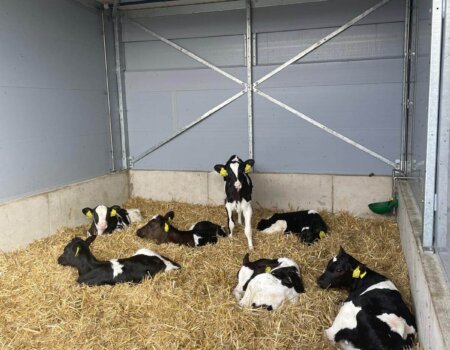Smart calf shed design, strong calves
Every dairy farmer wants to raise calves in a healthy way. Yet calf diarrhoea remains a persistent problem that demands a lot of time and energy. Early group housing offers advantages for growth and behaviour, but it also raises questions: Does group housing increase the risk of diarrhoea? And how does shed design help to prevent it?
A well-designed calf shed with smart hygiene solutions makes the difference between recurring problems and vital calves. In a calf shed where hygiene, climate and layout are properly aligned, infection pressure stays low even in early group housing. At Topcalf we design calf housing with one clear goal: raising healthy calves in a practical and hygienic way.

All-in all-out: every group a fresh start
One of the most effective measures against calf diarrhoea is the all-in all-out principle. In a Topcalf calf shed, calves can be placed and removed per group at the same time. Once a group leaves, the section is mucked out, thoroughly cleaned and disinfected before new calves arrive.
This prevents older calves from passing pathogens on to younger animals. Each group starts in a clean and fresh environment, directly contributing to fewer cases of diarrhoea and healthier calves.
Mechanical cleaning: hygiene made easy
Good hygiene requires not only discipline, but above all convenience. That’s why we design our calf housing in such a way that mechanical cleaning is quick and efficient. The solid concrete partitions and smooth plastic walls make it easy to empty the calf shed completely and clean it thoroughly with a pressure washer.
What’s easy to keep clean, stays clean. After each group of calves, the old and damp straw is removed, preventing ammonia build-up and keeping the air in the calf shed fresh and healthy.

Sloped concrete floor: keeping the lying area dry
An important detail that is often underestimated is the sloped floor. A slightly inclined surface ensures that urine drains directly from the lying area into the gutter. This keeps the straw dry and fresh for longer, significantly improving shed hygiene. A dry lying area not only prevents wet spots and ammonia formation, but also reduces the risk of infections and calf diarrhoea. In addition, proper drainage saves on straw usage and cleaning time.
Less calf diarrhoea, even with early group housing — it’s possible!
Group housing doesn’t have to pose a risk to calf health. With a well-thought-out shed design, a clear working routine and practical hygiene solutions, you can keep infection pressure low and your calves healthy. The Topcalf Calf Shed combines all-in all-out management, mechanical cleaning and a sloped floor into a practical, future-proof solution for modern dairy farmers. Because healthy calves start with a shed that makes hygiene easy.